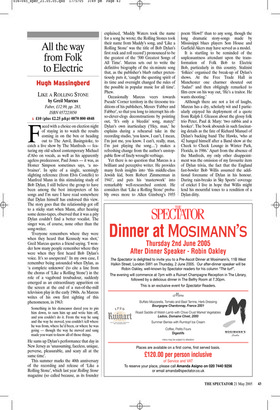All the way from Folk to Electric
Hugh Massingberd
LIKE A ROLLING STONE by Greil Marcus Faber, £12.99, pp. 283, ISBN 057223850 & £10 (plus £2.25 p&p) 0870 800 4848 Faced with a choice on election night of staying in to watch the results coming in on the box or heading out to The Anvil, Basingstoke, to catch a live show by The Manfreds — featuring my old school contemporary Michael d’Abo on vocals, as well as his apparently ageless predecessor, Paul Jones — it was, as Homer Simpson sometimes says, ‘a nobrainer’. In spite of a single, seemingly slighting reference (from Elvis Costello) to Manfred Mann in this stimulating study of Bob Dylan, I still believe the group to have been among the best interpreters of his songs and I’m sure I have read somewhere that Dylan himself has endorsed this view. The story goes that the relationship got off to a sticky start when Mann, after hearing some demo-tapes, observed that it was a pity Dylan couldn’t find a better vocalist. The singer was, of course, none other than the song-writer.
‘Everyone remembers where they were when they heard that Kennedy was shot,’ Greil Marcus quotes a friend saying. ‘I wonder how many people remember where they were when they first heard Bob Dylan’s voice. It’s so unexpected.’ In my own case, I remember being astounded when Dylan, as ‘a complete unknown’ (to cite a line from the chorus of ‘Like a Rolling Stone’) in the role of a vagabond troubadour, suddenly emerged as an extraordinary apparition on the screen at the end of a run-of-the-mill television play in the early 1960s. As Marcus writes of his own first sighting of this phenomenon, in 1963:
Something in his demeanor dared you to pin him down, to sum him up and write him off, and you couldn’t do it. From the way he sang and the way he moved, you couldn’t tell where he was from, where he’d been, or where he was going — though the way he moved and sang made you want to know all of those things.
He sums up Dylan’s performance that day in New Jersey as ‘unassuming, faceless, unique, perverse, pleasurable, and scary all at the same time’.
This summer marks the 40th anniversary of the recording and release of ‘Like a Rolling Stone’, which last year Rolling Stone magazine (so called because, as its founder explained, ‘Muddy Waters took the name for a song he wrote; the Rolling Stones took their name from Muddy’s song, and ‘Like a Rolling Stone’ was the title of Bob Dylan’s first rock and roll record’) pronounced to be the greatest of the ‘500 Greatest Songs of All Time’. Marcus sets out to write the definitive biography of the six-minute song that, as the publisher’s blurb rather pretentiously puts it, ‘caught the questing spirit of its time and overnight changed the rules of the possible in popular music for all time’. Phew.
Occasionally Marcus veers towards Pseuds’ Corner territory in the tiresome traditions of his publishers, Messrs ‘Fabber and Fabber’, so that you long to interrupt his ohso-clever-clogs deconstructions by pointing out, ‘It’s only a bleedin’ song, matey!’ Dylan’s own inarticulacy (‘Hey, man,’ he explains during a rehearsal take in the recording studio, ‘you know, I can’t, I mean, I’m just me, you know. I can’t, really, man, I’m just playing the song...’) makes a refreshing change from the author’s unstoppable flow of finely wrought verbiage.
Yet there is no question that Marcus is a brilliant and perceptive writer. He provides many fresh insights into ‘this middle-class Jewish kid, born Robert Zimmerman in 1941’, and puts his ‘masterwork’ into remarkably well-researched context. He considers that ‘Like a Rolling Stone’ probably owes more to Allen Ginsberg’s 1955 poem ‘Howl!’ than to any song, though the long dramatic story-songs made by Mississippi blues players Son House and Garfield Akers may have served as a model.
It is startling to be reminded of the unpleasantness attendant upon the transformation of Folk Bob to Electric Bob, particularly in this country. Stalinist ‘folkies’ organised the break-up of Dylan’s shows. At the Free Trade Hall in Manchester one charmer shouted out ‘Judas!’ and then obligingly remarked to film crew on his way out, ‘He’s a traitor. He wants shooting.’ Although there are not a lot of laughs, Marcus has a dry, scholarly wit and I particularly enjoyed his deployment of a quote from Ralph J. Gleason about the glossy folk trio Peter, Paul & Mary: ‘two rabbis and a hooker’. The book abounds in such fascinating details as the fate of Richard Manuel of Dylan’s backing band The Hawks, ‘who at 42 hanged himself after a Band show at the Cheek to Cheek Lounge in Winter Park, Florida, in 1986.’ Apart from the absence of the Manfreds, my only other disappointment was the omission of my favourite item of Dylan trivia, the fact that the England fast-bowler Bob Willis assumed the additional forename of Dylan in his honour. During rain-breaks in Sky Sports’ coverage of cricket I live in hope that Willis might lend his mournful tones to a rendition of a Dylan ditty.

























































 Previous page
Previous page